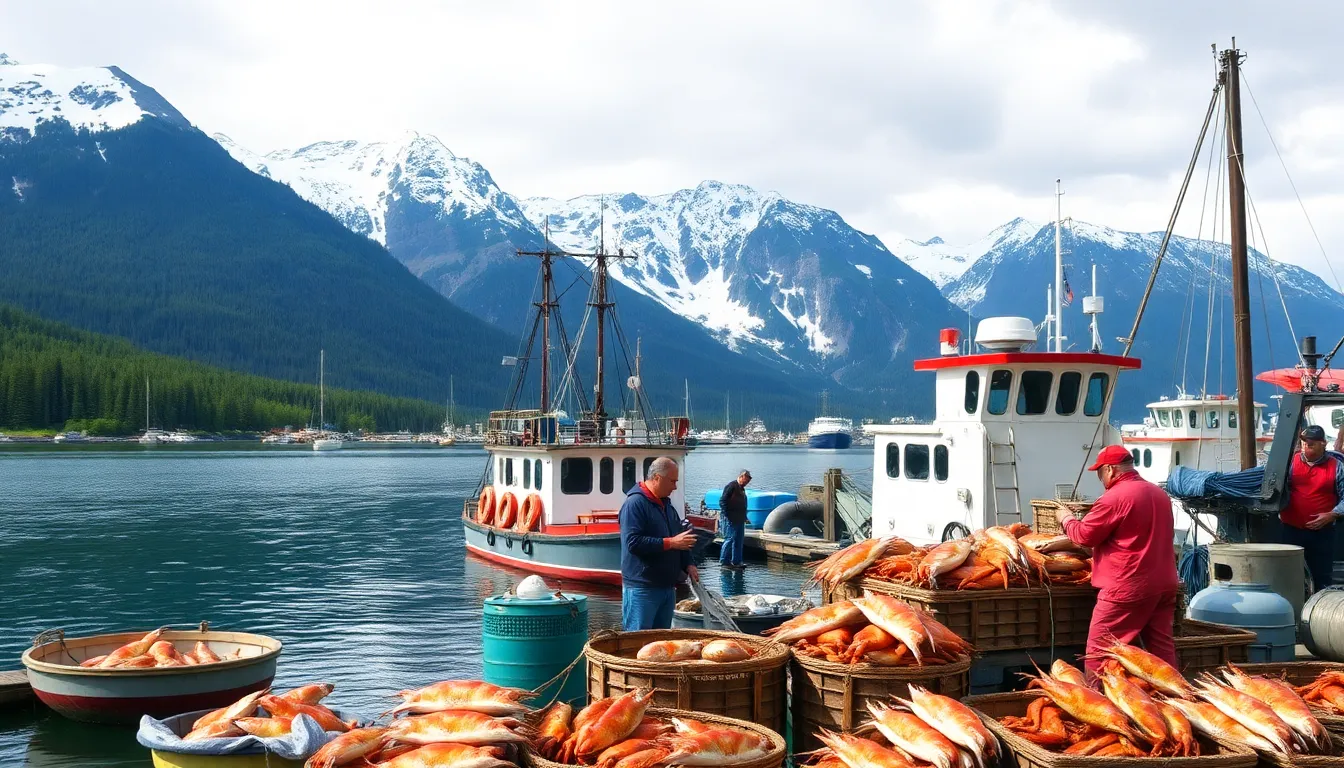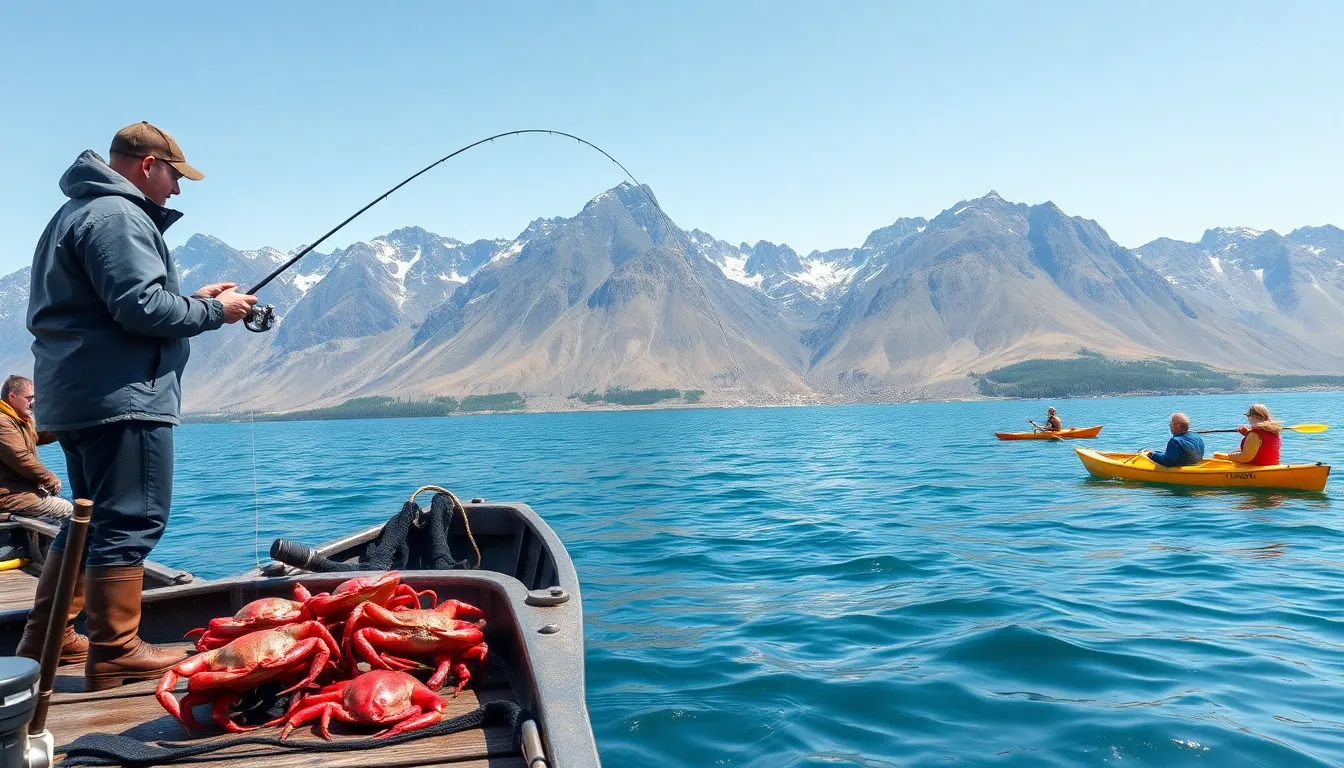Table of Contents
ToggleAlaska’s economy is as vast and varied as its breathtaking landscapes. From the icy shores of the Arctic to the bustling streets of Anchorage, economic trends in the Last Frontier reveal a unique story of resilience and adaptation. Whether it’s oil, fishing, or tourism, each sector plays a starring role in this economic drama, often with plot twists that could rival a Hollywood blockbuster.
Overview of Alaska Economic Trends
Alaska’s economy shows significant diversity. Oil and gas extraction remains a cornerstone, contributing approximately 30% of state revenue. Fishing also plays a vital role, with commercial fisheries generating nearly $200 million annually in seafood exports. Tourism experiences steady growth, attracting around 2 million visitors each year, who contribute billions to local economies.
Significant fluctuations in oil prices can impact state budgets. When oil prices increase, revenue tends to rise, improving funding for public services. Conversely, low oil prices challenge economic stability, prompting shifts in government spending.
Investments in renewable energy are on the rise, reflecting a growing focus on sustainability. Projects in wind and solar energy aim to diversify Alaska’s energy portfolio. Additionally, technology startups are emerging, fostering innovation within the state. Alaska’s unique geographical advantages and natural resources create opportunities for new businesses.
Labor markets also exhibit varied trends. Employment in tourism spikes during summer months, while winter months see a slowdown. In contrast, mining jobs remain steady year-round due to ongoing production needs.
Despite its economic challenges, Alaska demonstrates resilience. Federal stimulus efforts and infrastructure projects contribute to job creation and economic growth. Overall, the state’s economy continues to evolve, adapting to global market shifts and local resource dynamics.
Key Industries Impacting the Economy

Alaska’s economy thrives on several key industries that significantly influence its financial landscape.
Oil and Gas Sector
The oil and gas sector remains a cornerstone of Alaska’s economy. It contributes approximately 30% of the state’s revenue, highlighting its importance. Fluctuations in oil prices directly impact state budgets, influencing funding for essential services. Although the state’s oil production has declined from previous highs, it continues to attract substantial investments. This industry also supports thousands of jobs across various regions, underscoring its role in maintaining economic stability.
Tourism Industry
Tourism plays a crucial role in Alaska’s economy, attracting around 2 million visitors annually. Travelers contribute billions to the local economy, benefiting various businesses and communities. Seasonal variations impact this sector, with peak activity occurring during the summer months. Adventure tourism, including kayaking and wildlife viewing, gains popularity, showcasing Alaska’s natural beauty. Efforts to enhance infrastructure and promote sustainable practices focus on sustaining growth in this vibrant industry.
Fishing and Seafood Processing
Fishing and seafood processing significantly contribute to Alaska’s economic vitality. The industry generates nearly $200 million annually in seafood exports, affirming its importance. It employs thousands of Alaskans, providing jobs and supporting local communities. Salmon, cod, and crab represent key species driving export revenues. Commitment to sustainable fishing practices ensures long-term viability and environmental health, highlighting the sector’s adaptation to market demands and environmental standards.
Economic Challenges Facing Alaska
Alaska faces several economic challenges that impact its growth and stability. These challenges stem from geographic isolation, market fluctuations, and environmental changes.
Remote Location and Infrastructure Issues
Isolation presents a unique obstacle. Many Alaskan communities remain remote, making transportation of goods costly and time-consuming. Roads and airports often require significant investment to maintain or improve. Limited infrastructure hampers business development, especially in rural areas. Addressing these concerns remains critical to enhancing connectivity and supporting economic participation across the state.
Fluctuating Oil Prices
Oil price volatility significantly affects state revenue. Budget constraints arise when prices fall, impacting funding for essential public services. Alaska’s heavy reliance on oil creates vulnerability during market downturns. Decreasing production levels further exacerbate these issues while prompting discussions about economic diversification. Strategies focusing on stabilizing revenue streams can help mitigate the risks associated with these fluctuations.
Climate Change Impacts
Climate change poses serious threats to Alaska’s economy. Rising temperatures affect traditional industries such as fishing and tourism. The decline of sea ice disrupts marine ecosystems, impacting fish populations crucial for exports. Coastal communities experience increased flooding and erosion, threatening infrastructure and livelihoods. Adapting to these environmental changes demands attention and resources to sustain economic resilience while protecting natural resources.
Recent Economic Developments
Alaska’s economy currently exhibits noteworthy changes across different sectors. Recent trends indicate significant shifts in state revenue streams, employment opportunities, and business growth.
State Budget and Revenue Changes
Changes in the state budget reflect fluctuating oil prices and evolving revenue sources. Oil and gas extraction contributes approximately 30% of state revenue, yet recent production declines have raised concerns. Budget constraints impact funding for public services, necessitating careful financial planning. Anchorage’s city budget, for instance, highlights a focus on maintaining essential services amid these fluctuations. Local governments are also exploring alternative revenue sources to ensure financial stability and enhance infrastructure investments.
Employment Trends
Employment patterns in Alaska vary throughout the year, with tourism jobs surging during summer months. Seasonal positions significantly contribute to the overall labor market, as around 2 million annual visitors stimulate countless opportunities. Fishing and oil sectors maintain steady jobs, supporting thousands of Alaskans. Adaptability in the workforce remains crucial for responding to changing economic conditions. New sectors such as technology startups illustrate Alaska’s evolving job landscape, fostering innovation and diversifying employment options.
Business Growth and Investments
Business growth demonstrates resilience amid challenges, with investments in renewable energy increasing. These investments align with statewide sustainability goals, promoting long-term economic stability. The technology sector is also gaining momentum, drawing attention from entrepreneurs and investors. Strategic infrastructure improvements are essential for supporting new ventures and attracting talent. Moreover, ongoing federal stimulus efforts bolster local economies, fostering an environment conducive to growth and innovation.
Future Outlook for Alaska’s Economy
Alaska’s economy shows signs of potential growth amid ongoing challenges. The state’s diverse economic sectors continue evolving, adapting to changing market demands.
Economic Forecasts
Recent projections indicate a modest recovery in oil prices, expected to stabilize around $75 per barrel over the next few years. Economic analysts anticipate steady job growth, particularly in the tourism and renewable energy sectors. The fishing industry may see continued exports driven by high demand for Alaskan seafood, with revenues projected to maintain or increase slightly. Alaska’s overall GDP could grow by approximately 2% annually, reflecting improvements in infrastructure and investment opportunities.
Opportunities for Growth
Investment in renewable energy technologies offers significant potential for Alaska’s economic advancement. Amid growing interest in sustainable practices, the state may attract funding for wind, solar, and geothermal projects. Furthermore, tourism diversification shows promise with expanding adventure tourism options, enhancing visitor experiences. Strengthening transport and communication infrastructure stands as a critical area for development, enabling businesses to thrive. Federal support for local infrastructure projects may also bolster job creation, paving the way for economic resilience.
Alaska’s economic landscape is marked by resilience and adaptability across key sectors. The interplay of oil, fishing, and tourism highlights the state’s unique strengths while revealing the challenges it faces. As the economy evolves, investments in renewable energy and technology are paving the way for future growth.
With a focus on sustainable practices and infrastructure improvements, Alaska is well-positioned to navigate its geographic and economic hurdles. The anticipated recovery in oil prices and the ongoing demand for Alaskan seafood further bolster optimism. As the state embraces diversification and innovation, it can create a more stable and prosperous economic future for its residents.




